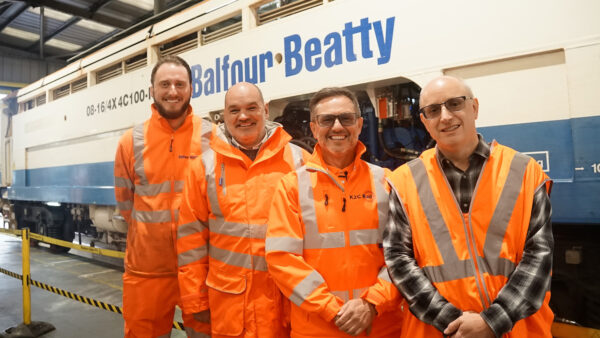
Image from forward facing CCTV showing the incident (image courtesy of London North Eastern Railway)
A track worker who was acting as a site lookout for a colleague narrowly avoided being struck by a train travelling at 102mph near Peterborough station, an investigation has revealed.
The incident on 20 July 2018 occurred just after the train had passed through the station. The driver saw the lookout standing on the same line ahead. The driver immediately sounded the train’s warning horn and applied the brakes. The lookout moved out of the train’s path about 2.5 seconds before it reached him.
An investigation by the Rail Accident Investigation Branch (RAIB) found four causes for the incident. The site lookout was distracted and not adequately observing his distant lookout or looking for approaching trains. He had also chosen to stand on an open line when it was not necessary to do so.
The track worker carrying out the inspection, who was also the controller of site safety and responsible for the safety of all the staff involved in the work, was not monitoring the unsafe actions of the lookout at the time of the incident.
Lastly, the distant lookout had left his position before the train arrived because he thought he had been stood down. A distant lookout who was visible to the site lookout was from a different team and was looking out for trains coming in the opposite direction.
The investigation also found that the way in which the work was planned defaulted to using the least preferred safe system of work in the hierarchy within Network Rail’s company standard for managing the safety of people at work on or near the line. It added that the current rules for communication when lookouts are used are impractical, leading to a disregard for the rules and the use of unofficial and uncontrolled practices.
Rule change
The RAIB has made five recommendations to Network Rail relating to the following areas:
- a rule change so that site lookouts default to standing in a position of safety, unless this is not practicable, to implement the safe system of work;
- investigating the common but unofficial use of flag signals by lookouts to communicate, finding ways to improve and control this communication, implementing changes and monitoring the effectiveness of the changes that are made;
- clarifying to track workers the actions they should take when more than one group wants to work with lookouts in the same place;
- continuing the ongoing work of the Network Rail route involved to reduce the use of lookouts for cyclic maintenance tasks;
- reducing the number of cyclic maintenance tasks that are undertaken using lookouts across all of Network Rail’s infrastructure.
The investigation also identified three learning points about the importance of early use of the train’s horn by drivers to give an urgent warning, which probably averted an accident in this case; the briefing of lookouts on where to stand while carrying out their duties; and staff responsible for the safety of the work group not becoming distracted by the work activities to the extent that they are no longer observing the group.
Simon French, chief inspector of rail accidents said: “In my introduction to the RAIB’s Annual Report for 2018, I said that the number of near misses involving trains and track workers which we have seen in recent years is hugely disappointing. The subject of this report is another of these events – in this case the worker concerned moved clear of the line less than three seconds before the train passed him.
Catalogue of problems
“This narrowly avoided collision between train and man took place during routine inspection work. The catalogue of problems with on-site organisation and communication that we found in this investigation was alarming. Some of the people involved made assumptions about what was happening, and the lookout allowed himself to be distracted from the vital duty of warning of approaching trains.
“It is disappointing that the planning of the work had resulted in it being done while trains were running. The team involved did most of their work in this way, and of all the different maintenance teams at Peterborough, they were the least likely to plan work in periods when there were no trains.
“The investigation highlights the difficulty of managing effective communications between controllers of site safety and the lookouts that they have placed at locations remote from the site of work. A number of unofficial flag signals were being used to transmit messages, and this was a factor in the Peterborough incident. For this reason, we are recommending that Network Rail investigates the methods of communication that are actually being used in these circumstances, and comes up with practical measures that will make life safer for teams working on the track.”










